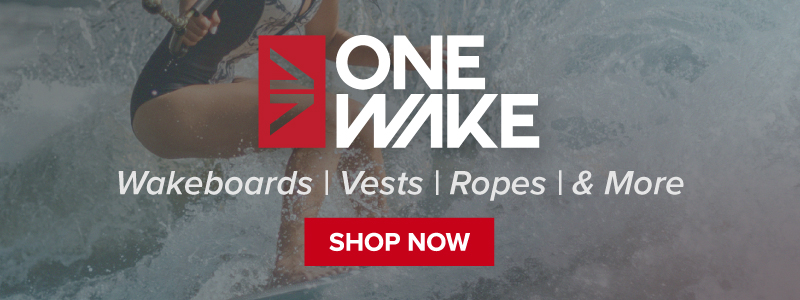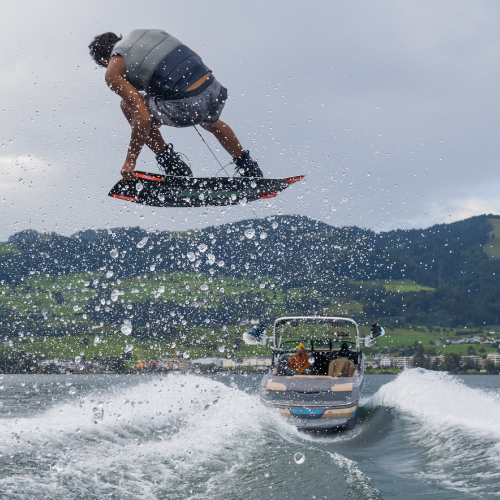Wakeboarding for Beginners: A Guide
Cruising the water is nice and all, but sometimes a little adrenaline rush is just what you need to make the day. If you really want to “shred the gnar” and add some excitement to your time on the water, perhaps wakeboarding is for you!
Of course, it’s easier said than done to stand on a board being pulled at high speeds by a boat and skim over the surface of the water (okay, that was pretty hard to say…). Wakeboarding, for beginners, can seem daunting. It does have a somewhat steep learning curve, but it’s worth it once you get the hang of it. If you’re a beginner, here’s what you need to know to enter the exciting world of wakeboarding.
What is Wakeboarding?
If you take surfing, water skiing, and snowboarding, put them all in a blender, and turn it on, you get wakeboarding! Riders stand sideways on a board, hold onto a rope, and get pulled across the surface of the water by a boat going up to 30 miles per hour.
While that might sound crazy, it gives riders the feeling of surfing on an endless wave. You skim across the surface of the water and can perform all kinds of maneuvers, including high-flying aerial jumps and spins over boats’ wake — hence, “wake” boarding.

The Tools to Success: What You’ll Need
You can’t just jump out the back of a moving boat with just a few positive thoughts and hope to wakeboard. You’ll need some gear to get started.
To begin your wakeboarding journey, you’ll need at least the following gear:
- Wakeboard – The actual board you stand on.
- Bindings and boots – Bindings and boots keep your feet securely connected to the wakeboard.
- Life jacket – Wakeboarding is an extreme sport, so always remember: safety first!
- Tow rope (with handle) – Attach it to the boat and hold on!
- A quick boat – You’ll need something with enough power to pull you out of the water and enough speed to keep you skimming atop the water’s surface.
While these are the wakeboarding essentials, it also doesn’t hurt to have a wakeboarding helmet (just in case) and a wetsuit or drysuit for colder conditions.
Although it seems straightforward enough, there’s a wide variety of options for each piece of gear. For example, adjustable boots and bindings are great if you want to share the board between multiple people, but they won’t be as strong as set boots and bindings made specifically to fit your feet.
It’s important to do your research about each piece of equipment to find what best fits your needs, goals, and budget. There’s nothing more frustrating than trying to use gear that’s not right for your capabilities, and it can hinder your ability to learn or stick with it.
How to Choose the Right Size Wakeboard
Wakeboards come in many shapes and sizes. Longer wakeboards have more buoyancy, so typically heavier riders need longer wakeboards.
Here’s a quick wakeboard size chart to give you a general idea about the length of wakeboard you’ll need:
| Rider weight | Wakeboard length |
| <100lbs | <130cm |
| 90-150lbs | 130-134cm |
| 130-180lbs | 135-139cm |
| 170-250lbs | 140-144cm |
| 200-275+lbs | >144cm |
While this might give you an idea of what to look for, it’s just a general sizing chart. Every wakeboard should come with a sizing recommendation from the manufacturer. It’s important to read this information before purchasing a wakeboard, so you know if the board you choose is right for your height and weight.
For beginners, it’s also best to choose a wakeboard with a twin tip or double-ended design with both ends upturned. This will allow you to ride in either direction and make it easier to determine the feel you like best.

What Kind of Boat is Best for Wakeboarding?
Believe it or not, a boat that’s great for water skiing or tubing probably won’t be ideal for wakeboarding. The key to a good wakeboarding boat is right in the name of the sport: wake. It comes down to hull design and internal ballast.
Wake comes from the boat’s displacement. The more displacement, the bigger the wave. Since you want a nice big wake for wakeboarding, you’ll want a boat with a deep-V hull and plenty of weight (internal ballast) to push the hull farther down into the water.
You might think beginners wouldn’t want a massive wake to learn on, but that deep-V hull does more than just make a surfable wave; it also cuts through other waves and flattens them out. You could be riding on the choppiest lake around, and the wake immediately behind the boat will be flat as can be! You can learn to wakeboard on the calm behind the boat and venture beyond the wake as you grow your skills. Plus, it’s a more comfortable ride for your friends in the boat.
A big hull and plenty of internal ballast can be difficult to push through the water, so you want to make sure your boat has plenty of power to get the boat up to plane quickly and yank the wakeboarder out of the water. While you may be able to wakeboard with a smaller engine as low as 25 horsepower, you’ll be much more comfortable with a boat that has at least 90hp but preferably 135+hp.
How to Wakeboard
Once you have all the gear, it’s time to give wakeboarding a shot! Here are the general steps to help you get up on a wakeboard for the first time:
Step 1: Attach the rope
This step is pretty simple. Just attach your tow rope to the boat, with the handle in the water. Make sure you have a strong tow rope for safety. For beginners, it’s best to keep the rope relatively short so you get more upward pull from the boat, helping you get up and stay up while skimming over the water.
Step 2: Set your wakeboard
It’s time to strap in. Put your feet into the boots, and make sure the bindings are properly secured to the board. Your feet should be shoulder-width apart and turned slightly outward. Make sure you do this on the back of the boat, so you can easily jump out. You don’t want to hop your way back from the bow! (That can be embarrassing). And don’t forget your life jacket!
Once you’re strapped in, it’s time to let gravity do its thing and slide into the water.
Step 3: Line up
Float on your back just behind the boat. The board should be between you and the boat, sitting horizontally in the water. Hold the tow rope in your hands with your arms out straight. Your arms should be on either side of your knees, and your knees should be slightly bent. Hold this position and let the driver know you’re ready to go!

Step 4: Stand up
Once you feel the boat start pulling, let your knees bend even more toward your chest and keep your arms as straight as possible. Keep the board horizontal as it starts to plane on the water. As the boat pulls you out of the water, rotate the board so your dominant foot goes to the back. It’s a good idea to start slowly to reduce the risk of falling.
It’s common for beginners to want to straighten their legs once they stand up. While this is fine after you get a feel for it, it’s not suggested for beginners. It’ll only knock you out of position. It’s best for newbies to hold a crouched position until they’re completely out of the water and standing on the wakeboard.
Step 5: Hold on (and don’t forget to have fun!)
Now that you’re skimming on top of the water, stay slightly leaned back with the front tip of the wakeboard out of the water. If the front tip dips below the surface, you’ll quickly follow.
Once you get the feel for standing on the board, try leaning side to side (toe side and heel side) to turn the board within the wake of the boat. As you become more comfortable, you can experiment with touching the wake and eventually riding over it. From there, it’s up to you. Don’t forget to have fun!
Wakeboarding for Beginners
Wakeboarding might not be the easiest sport to start, but it’s a rewarding experience for those who stick with it to overcome the learning curve. Just remember to get the right gear for your weight and experience level, take your time, and be safe. With a little practice, you’ll be skimming the water and flying over wake in no time!
The post Wakeboarding for Beginners: A Guide appeared first on PartsVu Xchange.
